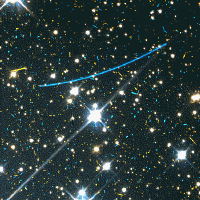Asteroid numbers and names
 Asteroid numbers and names
Asteroid numbers and names
This Hubble Space Telescope image shows an asteroid (blue trail) moving against the background stars. This asteroid has a diameter of about 2 kilometres and was located 87 million miles from Earth and 156 million miles from the Sun. Most asteroids are seen only as trails of light against the 'fixed' background stars.
The naming of an asteroid is the final step of a long process which may take decades to complete. It starts when the asteroid is first observed on two consecutive nights by one observer. These results are then sent to the Minor Planet Centre of the International Astronomical Union (IAU), which assigns a provisional designation. This is usually a serial number, such as 1992 KD.
The provisional designation includes the year of its discovery followed by two letters that give the order of its discovery during that year. Objects, discovered between 1 and 15 January, are designated in order of their discovery, AA, AB, AC, and so on. Those discovered between 16 and 31 January are given the letters BA, BB, BC, and so on. The final discoveries of the year, between 16 and 31 December, have designations in the series YA, YB, YC. (The letter J is not used.) For example, 1992 KD would have been the fourth asteroid discovery during the second half of May 1992.
Asteroid moons are given different designations. For example, S/1998(45)1 is the first satellite of asteroid (45) to be discovered during 1998.
Once the provisional designation is given, a search for former observations of the asteroid is done. Different sightings of the same asteroid may have led to it being given many provisional designations over time. When there is enough information to calculate an accurate orbit, a permanent number is assigned to the asteroid.
The Minor Planet Centre in the United States currently has records on the orbits of some 57 000 asteroids and 1050 comets. In 1999 alone, 25 000 new asteroids and 60 comets were discovered, but most of these have not been observed frequently enough for their orbits to be calculated with any accuracy. Only about 10 000 of the best-observed objects, which have fairly well-known orbits, have been given permanent numbers.
An asteroid with a permanent number will eventually be given a name. The astronomer who first provides enough observations to calculate the orbit with precision, has the privilege of choosing the name because they are the discoverer. However, the discoverer is not necessarily the first observer of the asteroid. The proposal is submitted to the Small Bodies Names Committee of the International Astronomical Union, which then makes official whether the proposal is considered to be acceptable.

